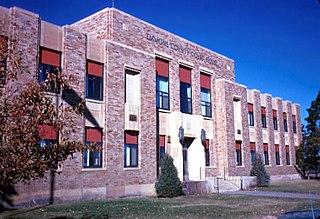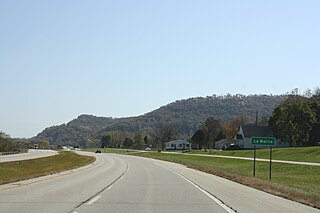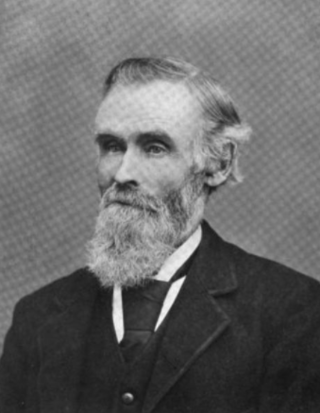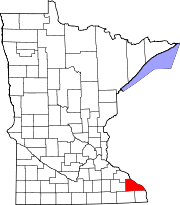
Clark County is a county in the U.S. state of Wisconsin. As of the 2020 census, the population was 34,659. Its county seat is Neillsville.

Emmons County is a county in the U.S. state of North Dakota. As of the 2020 census, the population was 3,301. Its county seat has been Linton since 1899.

Winona County is a county in the U.S. state of Minnesota. As of the 2020 census, its population was 49,671. Its county seat is Winona. Winona County comprises the Winona, MN Micropolitan Statistical Area.

Stark County is in Illinois. According to the 2020 census, it had a population of 5,400. Its county seat is Toulon.

Winona is a city in and the county seat of Winona County, Minnesota, United States. Located in bluff country on the Mississippi River, its most noticeable physical landmark is Sugar Loaf. The population was 25,948 at the 2020 census.

Timothy Davis was an attorney, businessman, and politician in Missouri and Iowa. He is most notable for his service as a one-term U.S. Representative from Iowa's 2nd congressional district.

Steve Drazkowski is an American politician serving as a member of the Minnesota Senate from District 20, representing all of Wabasha County, large parts of Olmsted County, Goodhue County, and Winona County, and a smaller part of Dakota County. He previously served in the Minnesota House of Representatives.
Trout Lake is an unincorporated community in the West Kootenay region of southeastern British Columbia. The former steamboat landing is at the north end of Trout Lake. The locality, on BC Highway 31, is by road about 177 kilometres (110 mi) north of Nelson and 90 kilometres (56 mi) by road and ferry southeast of Revelstoke.

This is a list of the National Register of Historic Places listings in Winona County, Minnesota. It is intended to be a complete list of the properties and districts on the National Register of Historic Places in Winona County, Minnesota, United States. The locations of National Register properties and districts for which the latitude and longitude coordinates are included below, may be seen in an online map.
Rancho Carne Humana was a 17,962-acre (72.69 km2) Mexican land grant in present-day Napa County, California, given in 1841 by Governor Juan Alvarado to Edward Turner Bale. The name means "human flesh" in Spanish. There is speculation as to why the name was chosen. The grant was originally known to the native residents as "Huilic Noma" and also "Colijolmanoc". One naming theory speculates that Bale, in a bit of black humor, twisted "Colijolmanoc" into the similar-sounding Spanish "Carne Humana". Rancho Carne Humana was at the northern end of the Napa Valley, stretching from present-day Rutherford northward to Calistoga, ending at Tubbs Lane and including present-day St. Helena.

Pickwick Mill is a historic gristmill in the unincorporated community of Pickwick, Minnesota, United States, near the city of Winona. It was constructed in the mid-1850s and is now operated as a milling museum. Pickwick Mill was listed on the National Register of Historic Places in 1970 for having state-level significance in the themes of agriculture, architecture, and industry. It was nominated for being one of southeast Minnesota's oldest surviving water-powered mills, serving as a key local industry in its day and a Winona County landmark to the present.

Lamoille is an unincorporated community in Richmond Township, Winona County, Minnesota, United States. Big Trout Creek and the Mississippi River meet at Lamoille.

Lavelle is a census-designated place that is located in Butler Township, Schuylkill County in the Commonwealth of Pennsylvania, in the United States. Situated on Pennsylvania Route 901, it was part of the Lavelle-Locustdale CDP for the 2000 census, before the communities were split into the two separate CDPs of Lavelle and Locustdale.

James John (1809–1886) was founder of the settlement of St. Johns in Oregon. The area later became a city when it passed a charter in 1902. It was annexed into Portland in 1915. John worked as a general store and ferry operator across the Willamette River to Linnton. He once served as Justice of the Peace and was twice an election judge. John was born in Ohio and first settled in Indiana with his wife and child where John worked as an educator. He joined the Bartleson–Bidwell Party in 1841, who were one of the first groups that trekked the California Trail. By this time, John's wife and child had died. He came to Oregon Country in the employment of the Hudson's Bay Company in 1843 after making it to Sacramento Valley.

Boyd Kevin Rutherford is an American politician, businessman and attorney who served as the ninth lieutenant governor of Maryland from 2015 to 2023.

The 2016 Minnesota House of Representatives election was held in the U.S. state of Minnesota on November 8, 2016, to elect members to the House of Representatives of the 90th Minnesota Legislature. A primary election was held in several districts on August 9, 2016. The election coincided with the election of the other house of the Legislature, the Senate.
The history of Winona, Minnesota as a settlement begins with the foundation in 1851 in what was then Minnesota Territory on the West side of the Mississippi River. The site was of the village of Keoxa of Dakota people. The name "Winona" (Wee-no-nah) was noted to be the name of a first-born daughter in the local Dakota language.

Joseph Ray Watkins was an American entrepreneur and founder of Watkins Incorporated with his homemade medical products – liniment, extracts, and salves. He offered the United States's first money back guarantee for his products and is credited as the founder of the direct sales industry.

John Emmitt was an American pioneer farmer and state legislator from the state of Oregon. He served four years in the Oregon State Senate as a Republican, representing a large rural district in western Oregon. Prior to being elected to the state senate, he was justice of the peace in Douglas County, Oregon. Later, Emmitt was appointed to the board of regents for Oregon Agricultural College.

The Trout Creek Outrage, also known as the Truckee Outrage or Trout Creek Murder, was an example of anti-Chinese violence in California which occurred on the night of June 17–18, 1876. White residents of Truckee, California set fire to two cabins along Trout Creek that housed six Chinese immigrants working as woodcutters approximately 2 mi (3.2 km) northwest of the town; as the woodcutters fled the fires, the Truckee men shot them, killing one and wounding another. Seven men were arrested two months later and tried for arson and murder in September 1876, but the lone defendant for the murder charge was found not guilty by an all-white jury after nine minutes of deliberation, and the arson charges against the men were dismissed. Ten years later in 1886, the citizens of Truckee succeeded in driving the last Chinese immigrants from the city, which previously had been the home of the second-largest Chinatown in the western United States.






















